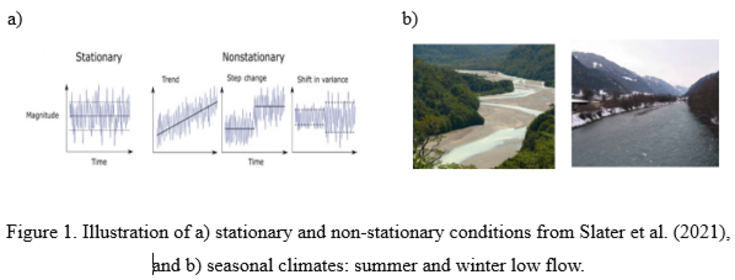The Impacts of Low Flow, Drought and Warming to the Functioning of River Systems
SUPERVISOR: Gregor LAAHA
PROJECT ASSIGNED TO: Farhana Sweeta FITRIANA
Rising global temperatures due to climate change are intensifying the frequency and severity of low-flow and drought events, posing significant risks for water management by reducing water availability and quality (Vliet et al., 2023). However, the effects of more intensified low flow and drought events on the functioning of river systems remain poorly understood. This study aims to address this critical knowledge gap by conducting an in-depth catchment analysis, focusing on two research questions: (i) What are the spatial and temporal dynamics of extreme low flow in the river system in response to rising temperatures and other climatic indices and (ii) How does water quality respond to low flow and increased temperatures, and which hydrological indices are most relevant for water quality.
To address the first research question, 175 catchments across Austria were analysed using the extreme value statistics approach. Traditional low-flow frequency analysis assumes stationarity and process homogeneity; however, these assumptions become questionable under the influence of climate change (Volpi et al., 2024) and varying generation processes for low flows (Tallaksen & Laaha, 2023). For example, in seasonal snow climate the annual extreme series will be a mixture of both summer and winter low-flow events with different generating processes. Temporal trends in low flow data were analysed to investigate potential links with temperature or other climatic indices. Statistical modelling concepts will be applied to extend the mixed distribution model of Laaha (2023) to incorporate non-stationary conditions, allowing to consider the detected trends in low flow frequency analysis and extrapolate into future scenarios. This model will then be further extended using a regionalisation approach to allow the prediction of design low-flows in ungauged catchments, providing improved characterisation of extreme low-flow conditions in both spatial and temporal contexts.
For the second research question, the link between hydrological characteristics, water temperature and water quality will be assessed. A statistical analysis will be performed to assess how low-flow and rising temperatures influence water quality parameters, such as nutrient concentrations, dissolved oxygen levels, and pollutant loads. The analysis will be based on existing temperature-dependent nutrient release and oxygen consumption curves (Duan & Kaushal, 2013). This will help identify which water quality indicators are most sensitive to low-flow and drought events and which hydrological indices can be used as predictors for potential water quality changes.
The findings of this study will offer a new perspective on the processes and impact chains associated with low-flows and droughts in river systems. This will enhance water resource management strategies and contribute to the protection of the functioning of river systems under climate change. Within the HR21 Doctoral school, this research is placed mainly within research cluster “Vulnerability” with connections to the clusters “Connectivity” and “Metabolism”.

References
Duan, S. W., & Kaushal, S. S. (2013). Warming increases carbon and nutrient fluxes from sediments in streams across land use. Biogeosciences, 10(2), 1193-1207. https://doi.org/10.5194/bg-10-1193-2013
Laaha, G. (2023). A mixed distribution approach for low-flow frequency analysis – Part 1: Concept, performance, and effect of seasonality. Hydrol. Earth Syst. Sci., 27(3), 689-701. https://doi.org/10.5194/hess-27-689-2023
Slater, L., Anderson, B., Buechel, M., Dadson, S., Han, S., Harrigan, S., Kelder, T., Kowal, K., Lees, T., Matthews, T., Murphy, C., & Wilby, R. (2021, 07/07). Nonstationary weather and water extremes: a review of methods for their detection, attribution, and management. Hydrology and earth system sciences, 25, 3897-3935. https://doi.org/10.5194/hess-25-3897-2021
Tallaksen, L. M., & Laaha, G. (2023). Chapter 6 - Frequency analysis∗∗This chapter builds upon: Tallaksen, L.M., Madsen, H., Hisdal, H., 2004. Hydroclimatology, Chapter 6. in: Tallaksen, L.M., Van Lanen, H.A.J. (eds), Hydrological Drought. Processes and Estimation Methods for Streamflow and Groundwater. Developments in Water Science, 48, Elsevier Science B.V., pp. 199-271. In L. M. Tallaksen & H. A. J. van Lanen (Eds.), Hydrological Drought (Second Edition) (pp. 233-304). Elsevier. https://doi.org/https://doi.org/10.1016/B978-0-12-819082-1.00003-5
Vliet, M. T. H. V., Thorslund, J., Strokal, M., Hofstra, N., Flörke, M., Ehalt Macedo, H., Nkwasa, A., Tang, T., Kaushal, S. S., Kumar, R., van Griensven, A., Bouwman, L., & Mosley, L. M. (2023, 2023/10/01). Global river water quality under climate change and hydroclimatic extremes. Nature Reviews Earth & Environment, 4(10), 687-702. https://doi.org/10.1038/s43017-023-00472-3
Volpi, E., Grimaldi, S., Aghakouchak, A., Castellarin, A., Chebana, F., Papalexiou, S., M, Aksoy, H., Bárdossy, A., Cancelliere, A., Chen, Y., Deidda, R., Haberlandt, U., Eris, E., Fischer, S., Francés, F., Kavetski, D., Rodding Kjeldsen, T., Kochanek, K., Langousis, A., Mediero Orduña, L., Montanari, A., Nerantzaki, S. D., Ouarda, T. B. M. J., Prosdocimi, I., Ragno, E., Rajulapati, C. R., Requena, A. I., Ridolfi, E., Sadegh, M., Schumann, A., & Sharma, A. (2024, 2024/10/25). The legacy of STAHY: milestones, achievements, challenges, and open problems in statistical hydrology. Hydrological sciences journal, 69(14), 1913-1949. https://doi.org/10.1080/02626667.2024.2385686
